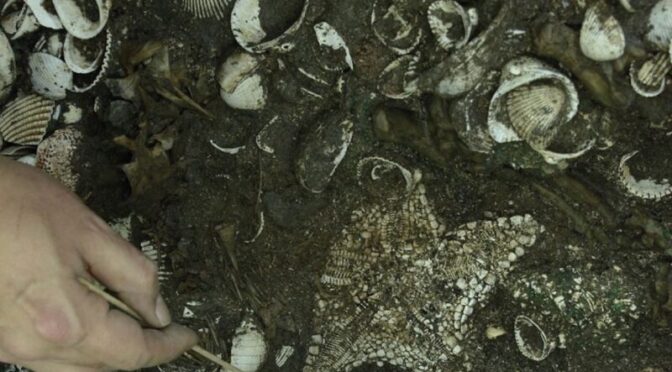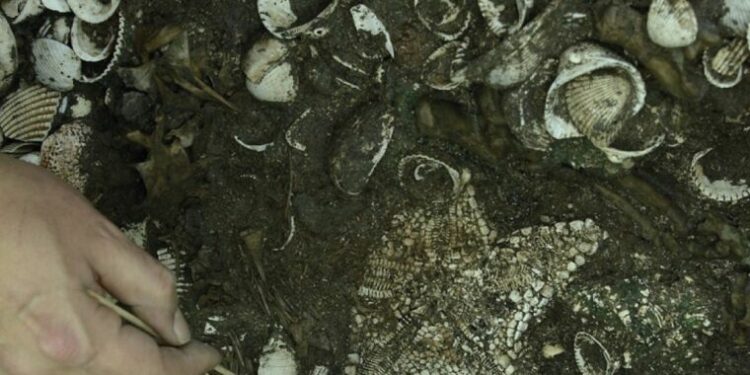A galaxy of starfish, along with a bounty of other things from the Aztec Empire’s far reaches, was offered to the war god Huitzilopochtli by Aztec priests at Tenochtitlán 700 years ago. The offering discovers later on the Templo mayor’s site, the principal temple in the Aztec city of Tenochtitlán, in what is now Mexico City, by archaeologists from Mexico’s National Institute of Anthropology History (INAH).
From coast to coast, Ahuizotl
The gift includes 164 starfish from the Nidorella aromatic species, also known as the chocolate chip starfish since it is essentially the color of cookie dough with dark markings. (It has the same moniker as another chocolate chip sea star, Protoreaster nodosus, a good case for scientific naming.) Nidorella armada can be found along the Pacific coast from Mexico to Peru, hanging out on rock and coral reefs in shallow water.

When Ahuizotl ascended to the throne in 1486, he immediately set about two critical projects: restoring the city, including the Templo Mayor, and expanding his empire’s frontiers. His operations doubled the Aztec Empire’s size, extending Aztec control west to Mexico’s Pacific coast and southeast to Guatemala. Because of their conquest, the Aztecs could readily carry starfish from the Pacific, corals from the Gulf of Mexico, and a variety of marine shells (including pufferfish) to Tenochtitlán to offer to their gods.
The conquistadors ruin everything
In the capital, Ahuizotl ordered that vast sections of the city be rebuilt. His activities included extending the Templo Mayor, which meant constructing a new, more extensive outer layer on top of the last temple in the Aztec language. (In many cases, the previous structure was ritually “killed” before the new one could be consecrated.) It is helpful for modern archaeologists, who can date each layer of the Templo Mayor’s construction.
According to Mexica legend, their leaders observed an eagle sitting on a prickly pear and eating a serpent there; it was the omen their priests had predicted from Huitzilopochtli and an image from the contemporary Mexican flag. The Mexica established a city called Tenochtitlán on the site and controlled the Aztec Empire from there.
Huitzilopochtli and Tlaloc, the rain and farming gods, shared the Templo Mayor; each god had his shrine at the top of the pyramid, accessible through separate staircases. The Templo mayor’s sixth stratum is Ahuizotl’s extension, which is where archaeologists discovered the starfish offering. Before destroying the temple, would add only one more layer.
Ahuizotl was the eighth and final monarch of the Aztec Empire before Hernán Cortés’ Spanish conquistadors arrived and ruined everything. Cortés landed during Ahuizotl’s nephew Moctezuma II’s reign, who died battling the invaders. The next king, Moctezuma’s brother, died of smallpox, a sickness brought by the Spaniards. Cuauhtémoc, Ahuizotl’s son, inherited the throne and surrendered to Cortés in 1521, only to be tortured for the location of mostly nonexistent riches and silver. Cuauhtémoc, the last monarch of the Aztec Empire, was murdered by Cortés in 1525.
Seashells for the god of war
Cortés had already demolished the Templo Mayor and begun constructing a Christian cathedral in its stead by the time Ahuizotl’s son died. In the twentieth century, archaeologists excavated the temple’s buried remnants. Still, they quickly discovered that most of the seventh and final layer made learning much from it impossible. The temple’s final well-preserved layer was the one Ahuizotl had built-in 1487. And it was there that investigators discovered the galaxy of starfish presented to Huitzilopochtli by Aztec priests.
The offering deposits in the Cuauhxicalco, a spherical structure that may have been where kings like Ahuizotl’s ashes were buried. According to historical records and other archaeological finds, archaeologists believe they were probably sacrifices to the battle god because they found the starfish and other things in a temple region that is usually linked with Huitzilopochtli.
The starfish, seashells, and pufferfish included a resin figurine of a female jaguar clutching an atlatl (a type of spear-thrower) in one claw. It isn’t the first time archaeologists have discovered starfish among the offerings at the Templo Mayor site, but it is the most incredible collection thus far. Because of global warming and centuries of human hunting, many starfish are more significant than their modern offspring.
One starfish, in particular, left a fossil-like record of its internal systems as well as its morphology.
“It was, perhaps, one of the first stars that the Mexica priests placed in the offering,” INAH explained. ” what is thought to be a layer of fiber beneath it when it received the weight of the jaguar and all the ingredients, preserving the mark of its internal structure.” “This is a unique circumstance because the other 163 stars’ remains are spread due to biological matter’s natural loss.”
What’s in a name, anyway?
You’re probably a My Little Pony fan or a tabletop RPG player if the name Ahuizotl seems familiar to you and you’re not a student of Aztec history. The Aztec ruler was named after a legendary beast that lived in swamps and around lakes. The creature resembled a dog but with monkey-like hands (one at the end of its tail) and spiky fur. It also killed one of Cortés’ soldiers, according to reports.
Both Dungeons & Dragons and Pathfinder have Ahuizotl, swamp-dwelling creatures that resemble the Mexica tale. A dog-like, spiky-furred character named Ahuizotl was a recurring enemy in My Little Pony: Friendship Is Magic. You now know.
After all, knowing is half the battle.























